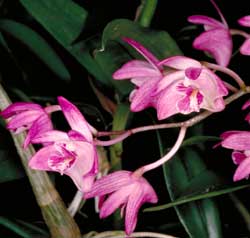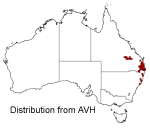Thelychiton kingianus
 |
formerly known as Dendrobium kingianum
Pink Rock Orchid
Dendrobium kingianum Bidwill ex Lindl.
Thelychiton kingianus (Bidwill ex Lindl.) M.A.Clem. & D.L.Jones
Thelychiton kingianus is native orchid in Australia and is most commonly called the Pink Rock Orchid or the Small Rock Orchid.
 This
species occurs naturally along eastern Australia from just above Newcastle to
the central Queensland highlands. This species grows naturally on rocky surfaces
and occasionally on tree logs, it can be found in warm temperate rain forests,
wet sclerophyll forests.
This
species occurs naturally along eastern Australia from just above Newcastle to
the central Queensland highlands. This species grows naturally on rocky surfaces
and occasionally on tree logs, it can be found in warm temperate rain forests,
wet sclerophyll forests.
It is important to note that collection of this species from the wild is illegal without a permit.
This species is a lithophytic orchid, however there have been cases of it growing epiphytically particularly on casuarinas. Thelychiton kingianus has a wide variety of growth forms it can grow in large clumps or individually, it can be miniature or a tall urn-shaped plant. The pseudobulbs themselves are highly variable in length they are broadest at the base tapering upwards to a narrow apex with longitudinal grooves. There are generally 2 to 7 leaves. There can be up to 15 flowers per pseudobulb. The flowers can be pure white to solid purple, most commonly there is a splash of purple or pale to mid mauve with a mid to deep purple speckled labellum. This species flower between the months of August and November, however this does depend on the age, size of the plant, and health of the plant.
This species of orchid is not frost tolerant so it must be sheltered from frosts, they do like full sun and partial shade, and probably one of the most important things is that plant has adequate air flow around it this particularly important for new growth.
This species can also be grown indoors where it would do well on a windowsill. Temperature is not a major problem here but humidity is, therefore kitchens and bathrooms are ideal. Thelychiton kingianus that are grown in cooler climates do best in plastic pots, preferably black or darkly coloured ones that absorb the heat, warm climate areas can use terracotta pots. It is recommended that Thelychiton kingianus is grown in a bark mix rather than standard potting mix; special orchid bark can be bought from most nurseries.
Correct watering of your orchid is very important, with a lot of orchids dying from being over watered. During the summer and spring months plants can be watered once a week, in winter which is this species rest phase water should be reduced and maybe be watered only once every two weeks or when the bark is dry.
Fertilising your plant correctly is also another important factor. This species generally has a low fertiliser requiremen. In general once a week a general orchid food can be applied , once a month a calcium solution can be applied and occasionally nitrogen all of this must be a dilute solution. All applications should be diluted. Nitrogen applications should stop in January and February. During winter fertilising is also reduced or stopped completely.
Propagation for this species is very easy. This most commonly used method is by harvesting the keikis. Keikis is a Hawaiian word meaning babies. Keikis are small plants that grow from a dormant bud on either the pseudobulb or flower spikes. They develop small roots and at this stage they may be cut away from the parent plant and potted separately.
Most common problems encountered when growing this species is attack from pests such as aphids, snails and slugs. Other problems include too much water, not enough light and air circulation.
Text by Jessica Newton (Botanical Intern 2003)
Name meaning Thelychiton kingianus Thelychiton – from two Greek words – thely = female, chiton = covered Dendrobium – means "tree-living" and refers to the epiphytic habit of many of the species of the group. kingianus – Named after Captain Phillip Parker King (1793-1856) who led early exploratory voyages around Australia. |
References
P.B. Adams & S.D. Lawson, (1995). Dendrobium Kingianum: A unique Australian Orchid. Central Queensland University Press, QLD
I. la Croix, (2000). Orchid basics. Octopus Publishing Group Limited, London
J.N. Rentoul, (1985). Growing Orchids – Book Three Vandas, Dendrobiums and Others. Lothian Publishing Company PTY Ltd, Sydney.
Clements, M.A. & Jones, D.L. (2002) Nomenclatural changes in the Dendrobieae (Orchidaceae) 1: The Australasian Region. The Orchadian 13(11)
![An Australian Government Initiative [logo]](/images/austgovt_brown_90px.gif)

